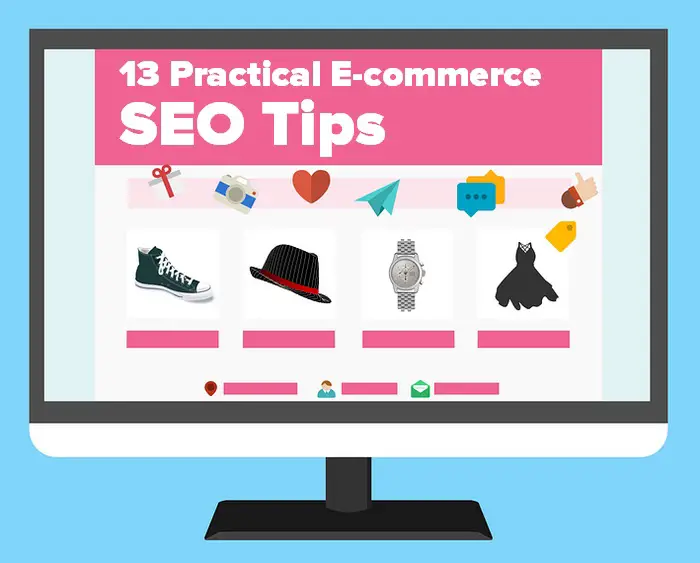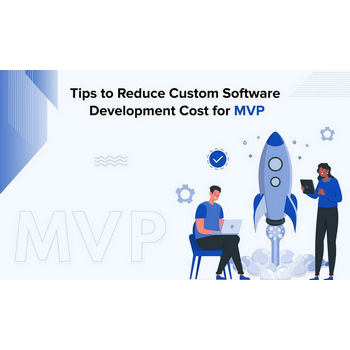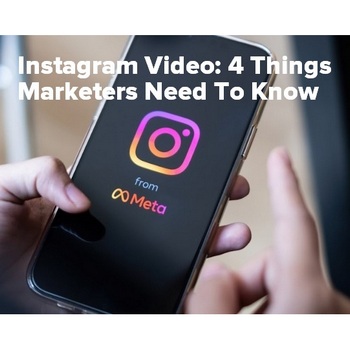In this new article, we share with you some practical e-commerce SEO tips that will help you bring in more sales in 2021.
Let’s get started!
An e-commerce store lives and dies by the amount of traffic it experiences.
You could have the world’s best products and website layout, but if you place poorly on Google’s search results page, none of it will matter.
SEO is a great way to bring in more people without spending money on advertising, but it needs to be done the right way in order to be effective.
SEO isn’t just about cramming in as many keywords as you can, and it should be seen as a strategy with many components.
With that said here are 13 of the best e-commerce SEO tips that will help bring you more traffic to your e-commerce store in 2021.

13 practical e-commerce SEO tips for your site
Analyze the competition
The first thing you’ll want to do is select five sites that your e-commerce business competes with.
Figure out who your top competitors are (if you don’t already know) by using tools such as SEMRush, or even by just searching on Google.
Conduct an evaluation of your competition and determine what they are doing well, and also where their weaknesses lie.
Next, look at your competitors’ top-selling products and their prices.
Pay special attention to things such as promotions and how often they offer discounts.
Look and see what the marketing strategy of your competitor is.
How do they position themselves and what is their message?
Finally, do an SEO audit on the competition, focusing on page titles, H tags, internal links, meta descriptions, and the calibre of their content.
Do some keyword research
Doing keyword research is another crucial early building block in any proper SEO strategy.
Without this kind of data, you’re basically flying blind.
Don’t just go with your gut.
Start by creating a list that includes every page on your site, and then on a page-by-page basis, select keywords for each one.
You can use the Scraper plugin to gain a complete list of all the URLs on your site; it saves a ton of time.
Obviously, optimizing each page will take a long time, so it’s best to start with your most important pages.
Optimize them, and then just keep moving on down the list.
So, what makes a good keyword?
Choose keywords based on things such as high volume, low competition, likeliness to convert, product-focused, and of course, their ability to rank.
A good keyword should tick as many of these boxes as possible, although you have to be realistic.
Some good keyword selecting tools include Serpstat, Google Keyword Planner, and even just using Google’s auto-complete function.
Prioritize the mobile experience
More and more people are accessing e-commerce stores on their mobile devices.
If you aren’t optimizing things for mobile then you are missing out on a huge opportunity, and maybe also living under a rock somewhere.
In 2017, mobile users made up 58.9% of online shoppers and spent $1.4 trillion!
Make sure your site loads quickly and is easy to use on mobile platforms.
Google uses your site’s mobile version as their starting point for how they index it, so a poorly done mobile version can doom your store’s SEO.
Make sure you optimize things like button size, navigability, and matching your mobile version’s look to your desktop version (people like continuity and it’s good for branding as well.)
You also should make sure you have a responsive design and that your mobile page speed and loading times are where they should be.
You can test how mobile-friendly your site is with Google’s Mobile-Friendly site test.
Join the conversation - We are talking E-Commerce SEO. Want to know how to give your store the edge? Check out these 13 E-commerce SEO TipsClick To TweetTry to avoid duplicating content
“Duplicate content can really be a hindrance to your e-commerce site’s SEO.
Having duplicate content is also a very common problem since your site could have many product descriptions.
Often sellers that list their products on multiple e-commerce sites write their own descriptions, so if it’s possible it’s always a good idea to take control of your product descriptions and rewrite these descriptions for better SEO.
Use on-page SEO
It’s important to optimize your category pages and product pages.
Your product page title tags should include words that you know your customers are already looking for, as well as provide the necessary details about your products. Your title should have the brand name, the product name, and then a keyword associated with that product.
Try experimenting with phrases like “buy now!”, “free shipping!” and “X% off!”
Your meta descriptions should have the product name and associated keywords you found through your research.
Your H1 titles need to reinforce the primary keywords for the page and don’t forget to make them user-friendly and easily readable.
Headers 2 through 6 should be placed in the same way you would do an outline.
Optimizing your product descriptions can be tricky and doing it right does take some time, but it’s vital to your sales.
Buyer personas obviously play a huge role in this, so hopefully creating some of those is part of your research and prep process.
Writing compelling copy is also a big part of a good product description.
Use creative, but easily understandable language, to motivate your buyer.
Keep everything easily digestible by spacing it out with bullet points; no one wants to read a wall of text.
Include some product reviews
Featuring some product reviews is always a good idea.
It’s a good way to keep some fresh content flowing on your site.
“Reviews will usually include lots of relevant keywords as well, further helping your site’s SEO,” recommends Andrew Reese, a regular contributor at DraftBeyond and Writinity.
Think of them as a way of including more keywords organically, while also increasing consumer trust in your brand and products.
Put videos on your product pages
People love videos and including them on your product pages makes it much more likely your page will rank well in Google’s search results.
Videos also make people a lot more likely to convert and actually buy your product.
Videos don’t need to belong, in fact, it’s better if they are short, sweet, and to the point.
Remember that this is the internet and people have very short attention spans.
You also don’t need to worry about making them too fancy, the point is for the customer to be able to view someone demonstrating how to use the product they are considering.
Don’t cram in as many keywords as possible
Cramming in keywords won’t help you.
You want to place your main keywords strategically and where they make sense logically.
Don’t sacrifice the flow of your copy to shove your keywords into your article.
Your descriptions should be catchy and easy to read, not a jumble of obviously shoved in keywords.
And you definitely don’t want to have a list of keywords at the bottom of your page; it will only hurt you and make you look like an amateur.
Use header and canonical tags
It’s important to use header tags on your product pages.
Not only are they very simple to add, but they will also improve your HTML structure, you can even use the product name as the H1 header tag.
It works very well for organizing your content, as well as enhancing your SEO.
Canonical tags can be used for organizing, as well as when you would like to prioritize a specific page over duplicate pages.
These tags are the easiest way to fix duplicate content, which is a problem every website has.
Proper site structure matters
The way users interact with and navigate your interface is a huge part of whether it is successful or not.
All your SEO optimization efforts can be wiped out by a clunky, poorly designed website layout.
The most important thing about your layout is that it makes sense intuitively to your customers; they shouldn’t need to do much figuring out.
The more time people spend looking for something or trying to understand something, the less time they spend buying.
And worse than that, it doesn’t take much for a person to just give up and go to another site.
There is plenty of competition out there.
Figure out the way your audience flows through a website by using tools such as Google Analytics.
Look at where your customers spent their time, and how they moved from page to page.
Make your internal search function easy to use and test to make sure it is sending your customers where you want.
Remember that your users will misspell things, use synonyms, and place spaces accidentally; factor these errors into your search function so you can get people where they want to be.
Optimize your URLs
A lot of people forget about optimizing their URL’s which is a big mistake because your URL’s are actually quite important to your site’s SEO.
A properly optimized URL can make it much more easy for a search engine’s bot to crawl your website and understand what it is you’re selling.
Make sure your URL slugs are as easy to read as possible.
Try and keep your URLs simple and intuitive and avoid repeating words.
Remember to include your primary keyword and make sure the hierarchy of your page is obvious.
Always use hyphens to separate words; do not use underscores, spaces, or any other symbol for this.
Whenever you can, avoid URL parameters.
Join the conversation - We are talking e-commerce SEO tips - Here are 13 practical SEO tips you can start using today! Do you have anymore we should add? Leave them as a comment on the article!Click To TweetBlog regularly
Have you always wanted to start a blog?
Well here’s your excuse, because keeping a regularly updated blog can be great for your e-commerce site and its SEO.
Your blog posts should be regularly scheduled and relevant to your customers’ interests and needs.
By creating a source of fresh new content, you will improve your site’s SEO, as well as making a connection with your audience and building up some trust.
They come to expect your blog posts, and you can start to feel like an old friend over time.
When you have new products to announce, talk about them in a fun and engaging manner on your blog.
Use your blog to educate and enhance your users’ experience with your product.
Answer commonly asked questions and inform your customers about different ways to use your product that they may not be aware of.
Optimize your product images
Images are a huge part of any e-commerce site, so don’t forget about optimizing them.
Your images are often the thing that triggers someone to make a purchase.
When it comes to your images, make sure they are good quality, interesting, and unique.
Images can also improve your site’s SEO.
Be sure to fill out your images’ ALT tag, which is a description of your image that should include your keywords.
And this leads us nicely onto our merchandising bonus tip
E-Commerce Merchandising – Bonus Tip
Owning an e-commerce business can be stressful, especially if your conversion rates are low.

13 Practical E-commerce SEO Tips for your site – Takeaways
E-commerce is a very competitive industry, so it’s important that you use any advantage you can get. SEO, when used properly, can make a huge difference in the success of your website.
The amount of traffic you receive determines how many potential customers come across your site and its products.
Remember that nothing else matters, if you don’t have people coming through, so get your SEO right.
Use these 13 practical e-commerce SEO tips for your website.
That’s all for now!
So do you own an e-commerce site?
Do you optimize your site for SEO?
Are my e-commerce SEO tips useful to you?
Let me know in the comments section below.
Make sure that you subscribe to the comments so that you are notified when I reply
Regards
James
Related Articles
Never do keyword research again. Do this instead
How to optimize for multiple keywords
- 13 Practical E-commerce SEO Tips for Your Site - January 7, 2019











Bluetechno
I don’t own an e-commerce site but I find this very useful. Pure value, thanks for sharing and I hope more and more people get lucky to read this article you provided to us without charging anything.
Bluetechno recently posted…TV-TWO, Webtalk, Bitdegree Review
Dexter Roona
I used to own one and had I known then what I know now about SEO I would have sold a lot more than I did especially after reading this article.
Dexter Roona recently posted…How to Grow Your Followers on Instagram and Tumblr
ers
Hi ,
Yoast plugins have helped many newbies to learn how to improve SEO of blog or e-commerce website posts. Yoast page analysis read the content and give suggestions to improve the quality to meet SEO standards. One should also focus on readability to boost content engagement.
Glad you have shared this.
ers recently posted…Best Domain Registrars 2019–for Cheap Domain Names
Dexter Roona
Yoast is what we use on Infobunny and our pages rank well as a result.
Dexter Roona recently posted…How to Publish Video Content on a Blog and Optimize for Video SEO
Anant
Thank you. These are really good tips to sell products online. Very helpful.
Milon
I think this is really a nice and useful Blog. I have learned many useful things and I also believe that others will surely be benefited. Thank’s for share this useful Blog with us. Thanks a lot.
Dexter Roona
Your right it is very informative and hits the mark.
Dexter Roona recently posted…8 Things You Need to Know About Sales Growth in Social Media Marketing
Nayan Jain
Ahh,
This is Nayan Jain (Freelance Digital Marketing Consultant), I would like to say thank you for sharing this helpful article on how we can optimize an eCommerce site for SEO.
Cheers
Nayan Jain recently posted…Shopify development services
Dexter Roona
Your welcome. Thanks for stopping by. I will check out your recent post 😉
Dexter Roona recently posted…How to Create A Logo: 5 Best Free and Paid Tools
Rihaan
Today, everyone is trying to establish their E-commerce SEO business online. They are looking for easy ways to market their products online. You have shared some useful tips here. Keep penning such posts to add to the knowledge of readers. Great post! Keep penning such posts and build the user interface.
Best Quality PVAS
Wow! amazing writing. Thank’s a lot.
Hannah Lagdameo
Such an amazing and informative read. Thank you so much sharing. All the best.
Hannah Lagdameo recently posted…How Google Hummingbird Affected SEO
PPC
Thanks for sharing this useful information.According to me Pay Per Click Advertising provides consistent results, I’m glad that you stopped by. When you get a chance let me know what you think of the tips here!
PPC recently posted…You don’t have to pay a fortune For Good SEO Service
Jannatul Jannat
I really appreciate your idea. thank’s…
DiscountOn
Hi James Scoville, I am a beginner and learn many things from your article.
ajangrala
Hello,
It was a very nicely written article. I like to read it. It was totally informative and topic you covered here, I am totally agreed with you. I must say that I have learnt so many things from it.
Thank you for sharing this article. Keep writing. Thank you so much.
Josephine
Hey James!!!
I read your blog on e-commerce SEO. All over is good I am also eCommerce app developer but the thing I face difficult is finding related and suitable keyword for the exact purpose. As you explain your article that a scraper is a good tool for keywords I’ll surely use that tool for my purpose. Hope I’ll get a better result.
Thanks for sharing such valuable information with us.
Josephine recently posted…How to do Ecommerce SEO?
Digital Aroma
13 Practical E-commerce SEO Tips for Your Site – Nice Article.
Rita
Wonderful post! We are linking to this great article. So much thank you to share us.
Voila
A quite educative post and SEO tips for eCommerce companies. We are also an eCommerce company specialized in KAM, Onboarding, Listing, Cataloging, Retail Services, Studio Photography.
Rich Degen
You have provided all the great tips which are very beneficial for us. Thank you for sharing.
Rich Degen recently posted…Does your Business’ Website Need A New Design?
Rick Ainso
I have an eCommerce site and these tips will surely be helpful for my online store.
Digital roy Academy
Amazing blog ! keep up the good work;) stay continued 🙂
Saurabh Soni
Hi,
Great post, thanks for sharing such useful tips.
For e-commerce, SEO is one of the major part of their marketing strategies.